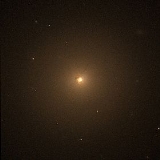
NGC 404
Encyclopedia
NGC 404 is a small lenticular galaxy located about 10 million light years away in the constellation
Andromeda
. It was discovered by William Herschel
in 1784, and is visible through small telescopes. NGC 404 lies just beyond the Local Group
but does not appear gravitationally bound to it. It is notable for being within 7 arc-minutes of second magnitude star Mirach, making it a difficult target to observe or photograph and granting it the nickname "Mirach's Ghost".
(LINER), a type of region that is characterized by spectral line
emission from weakly ion
ized atoms.
s distance measurement technique estimates distances to spiral galaxies based on the graininess of the appearance of their bulges. The distance measured to NGC 404 using this technique in 2003 is 9.9 ± 0.5 Mly
(3.03 ± 0.15 Mpc
).
However, NGC 404 is close enough that red supergiants can be imaged as individual stars. The light from these stars and knowledge of how they should compare to nearby stars within the Milky Way
galaxy allows for direct measurement of the distance to the galaxy. This method is referred to as the tip of the red giant branch (TRGB) method. The estimated distance to NGC 404 using this technique is 10.0 ± 1.2 Mly (3.1 ± 0.4 Mpc). Averaged together, these distance measurements give a distance estimate of 10.0 ± 0.7 Mly (3.07 ± 0.21 Mpc).
Constellation
In modern astronomy, a constellation is an internationally defined area of the celestial sphere. These areas are grouped around asterisms, patterns formed by prominent stars within apparent proximity to one another on Earth's night sky....
Andromeda
Andromeda (constellation)
Andromeda is a constellation in the northern sky. It is named after Andromeda, the princess in the Greek legend of Perseus who was chained to a rock to be eaten by the sea monster Cetus...
. It was discovered by William Herschel
William Herschel
Sir Frederick William Herschel, KH, FRS, German: Friedrich Wilhelm Herschel was a German-born British astronomer, technical expert, and composer. Born in Hanover, Wilhelm first followed his father into the Military Band of Hanover, but emigrated to Britain at age 19...
in 1784, and is visible through small telescopes. NGC 404 lies just beyond the Local Group
Local Group
The Local Group is the group of galaxies that includes Earth's galaxy, the Milky Way. The group comprises more than 30 galaxies , with its gravitational center located somewhere between the Milky Way and the Andromeda Galaxy...
but does not appear gravitationally bound to it. It is notable for being within 7 arc-minutes of second magnitude star Mirach, making it a difficult target to observe or photograph and granting it the nickname "Mirach's Ghost".
LINER emission
NGC 404 contains a low-ionization nuclear emission-line regionLow-ionization nuclear emission-line region
A low-ionization nuclear emission-line region is a type of galactic nucleus that is defined by its spectral line emission. The spectra typically include line emission from weakly ionized or neutral atoms, such as O, O+, N+, and S+. Conversely, the spectral line emission from strongly ionized...
(LINER), a type of region that is characterized by spectral line
Spectral line
A spectral line is a dark or bright line in an otherwise uniform and continuous spectrum, resulting from a deficiency or excess of photons in a narrow frequency range, compared with the nearby frequencies.- Types of line spectra :...
emission from weakly ion
Ion
An ion is an atom or molecule in which the total number of electrons is not equal to the total number of protons, giving it a net positive or negative electrical charge. The name was given by physicist Michael Faraday for the substances that allow a current to pass between electrodes in a...
ized atoms.
Distance measurements
At least two techniques have been used to measure distances to NGC 404. The infrared surface brightness fluctuationSurface brightness fluctuation
Surface brightness fluctuation is a secondary distance indicator used to estimate distances to galaxies. The technique uses the fact that galaxies are made up of a finite number of stars. The number of stars in any small patch of the galaxy will vary from point to point, creating a noise-like...
s distance measurement technique estimates distances to spiral galaxies based on the graininess of the appearance of their bulges. The distance measured to NGC 404 using this technique in 2003 is 9.9 ± 0.5 Mly
Light-year
A light-year, also light year or lightyear is a unit of length, equal to just under 10 trillion kilometres...
(3.03 ± 0.15 Mpc
Parsec
The parsec is a unit of length used in astronomy. It is about 3.26 light-years, or just under 31 trillion kilometres ....
).
However, NGC 404 is close enough that red supergiants can be imaged as individual stars. The light from these stars and knowledge of how they should compare to nearby stars within the Milky Way
Milky Way
The Milky Way is the galaxy that contains the Solar System. This name derives from its appearance as a dim un-resolved "milky" glowing band arching across the night sky...
galaxy allows for direct measurement of the distance to the galaxy. This method is referred to as the tip of the red giant branch (TRGB) method. The estimated distance to NGC 404 using this technique is 10.0 ± 1.2 Mly (3.1 ± 0.4 Mpc). Averaged together, these distance measurements give a distance estimate of 10.0 ± 0.7 Mly (3.07 ± 0.21 Mpc).

